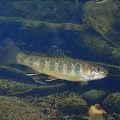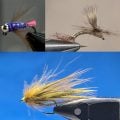How to Tie a Corded Midge Larva
Producer: Tim Flagler
This is an updated version of a midge larva pattern that I’ve had a good bit of success with over the last few years. It’s intended to imitate the midge larva that are commonly found during the winter, in many of the streams here in Northwestern New Jersey. The old pattern was a simple thread body and wire rib affair and functions just fine. But I think the updated version is more realistic.
For the newer fly, I’m going to use the same hook as the old, a Dai-Riki #270 in size 24. I start by carefully mashing the hook’s barb with a pair of fine-tipped needle nose pliers. I’ll then get the diminutive piece of iron firmly secured in the jaws of my tying vise.
For thread, I’ve loaded a bobbin with a spool of red UTC 70 Denier. Get your thread started on the hook shank behind the eye and take a few wraps rearward before snipping off the tag. Continue taking thread wraps down the shank ending with your thread at about the hook point.
Bright yellow Antron dubbing is used is for the body of the fly. Pluck an ample pinch free from the packet. Pull long wisps of the dubbing up parallel to your tying thread, and with a good bit of finger pressure, twist them clockwise onto the thread. Keep doing this until you’ve built up a fairly substantial 3” long dubbing noodle. I know this looks like a lot, but trust me, you’re going to need most of it in the end. Start taking wraps with the noodle so the dubbing begins well down into the hook bend. Make sure to get at least one full wrap of Antron around the hook. Double your tying thread over and secure it to the hook shank behind the eye with a few wraps, then snip the noodle end off close.
The dubbing noodle should now be on its own piece of thread. Using a ringed pair of plunger-style hackle pliers, get hold of the lower end of the dubbing noodle, not just the thread, and take a wrap around, then close the hook of the hackle pliers. This ensures the pliers won’t slip down the thread and part the dubbing noodle. You can then snip the excess thread end off close.
Pick up a dubbing whirl and hook it onto the ring of the hackle pliers then give the whirl a really good clockwise spin. Keep spinning the whirl while at the same time marveling at just how small and tight that dubbing noodle gets. When the dubbing noodle resembles a fuzzy thread, remove the dubbing whirl and unwind that full turn of dubbing you placed on the hook. Otherwise, you may be left with a loose ball of dubbing at the rear of the fly.
Start taking touching wraps up the hook shank with the noodle. The heavily corded noodle should give the body of the fly a segmented look. When you reach your tying thread, use it to anchor the noodle then snip the excess off close. Take wraps of tying thread to help clear fibers from the hook eye and establish a neat little head on the fly.
I like to darken the red thread with a brown magic marker then continue taking wraps to darken the entire head of the fly. Pick up your whip finish tool and use it to do a 4 or 5 turn whip finish, then seat the knot well and snip or cut your tying thread free.
Although not really necessary, fine-point, curved scissors can be used to trim away any extra-long fibers from the body of the fly.
Yeah, the fly looks pretty darn good in the jaws of the tying vise, but it’s underwater where it’s more likely to catch fish. Submerging the fly and giving it a swirl shows you what it will look like when it’s being fished. When wet, the Antron keeps its yellow color but becomes quite translucent, allowing the red thread wraps beneath to shine through. The result is a very lifelike appearance that closely matches the naturals.
How to Tie a Corded Cased Caddis
How to Tie a Crabby Patty San Flea











